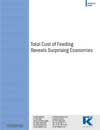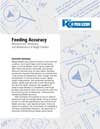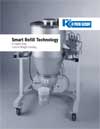|
General
|
|
|
|
|
|
|
|
|
|
Kason Products
|
|
|
|
|
|
|
|
|
|
|
|
|
|
|
|
|
|
|
|
K-Tron Products
|
|
|
|
|
|
|
|
|
|
|
|
|
|
Sturtevant Products
|
|
|
|
|
|
|
|
|
|
|
|
|
|
|
|
|
|
|
|
Western States
|
|
|
|
|
|
|
|
|
|
|
|
|
|
|
|
|
|
Abanaki Products
|
|
|
|
|
|
|
|
|
Download the following White Papers:
|
 Total Cost of Feeding Reveals Surprising Economies Total Cost of Feeding Reveals Surprising Economies
While it may be easy to obtain information on the acquisition cost of a new feeder line, it is more difficult to evaluate less obvious costs and potential savings of ongoing operation. Too often the savings an efficient feeding system can produce over time are not considered at the time of purchase and only the "up front" capital cost is reviewed. Like any process equipment, a feeding system costs something to acquire, performs a function, and costs something to support and sustain its ability to function as desired. Together, these three factors constitute the Total Cost of Feeding.
|

Vibrating Wire Weighing Technology in Process Feeding Applications:
The Evolution of the Revolutionary Smart Force Transducer
In the mid-1970's, K-Tron revolutionized bulk solids feeding with its introduction of the first truly digital load cell specially designed for process weighing applications. Based on an innovative vibrating wire concept, the new digital technology soon proved to be a significant advance over the analog LVDTs and strain gauges then in widespread use. This technical paper provides a detailed history about the vibrating wire theory, including the Smart Force Transducer (SFT) product evolution from the Digital Mass Transducer MK-II to today's Smart Force Transducer II & III . Article also explains the SFT's application to dry bulk material feeders and meters, including loss-in-weight feeders, weigh belt feeders, and the gravimetric flow meter.
|

Feeding Accuracy: The Measurement, Monitoring and Maintenance of Weigh-Feeders
Weigh-feeders have been around for more than half a century, but it hasn't been until the last twenty years or so that feeders could truly be called reliable. Early mechanical, pneumatic, and analog electronic devices were, by their nature, temperamental and required close attention to maintain even crude control of material flow. Now, though, with the sophistication of microprocessor control, digital weight measurement, and advanced mechanical design, reliably high accuracy is both the expectation and the reality. However, the capability of today's weigh-feeders to consistently meet tough process requirements does not excuse the user from his continuing duty of measuring, monitoring and
maintaining feeder accuracy. With hundreds of thousands of tons of material passing through an average feeder during its operating life, no one can quarrel about the economics of feeder accuracy. Less rejected product, more consistent formulations, the minimization of overfeeding, and less unscheduled downtime—all result from a practiced understanding of feeder performance.
|

Smart Refill Technology in Higher Rate Loss-in-Weight Feeding
Loss-in-weight feeders have evolved from mechanically ponderous devices to the sophisticated microprocessor controlled instruments of today. Weighing and control advancements over the years have made loss-in-weight (gravimetric) feeding the preferred method wherever the combination of high gravimetric accuracy, ingredient containment, and material handling capability are needed.
However, loss-in-weight feeding does possess some shortcomings, especially at higher feed rates. First, during the feeder's required hopper refill phase, weight-based control must be temporarily suspended and replaced with volumetric control. It is in this refill phase that significant feed rate errors can occur due to volumetric-control inaccuracies. And second, higher feed rates have historically meant physically large and expensive systems. In some cases required space could only be obtained at the cost of significant structural changes to the plant itself.
|
|

